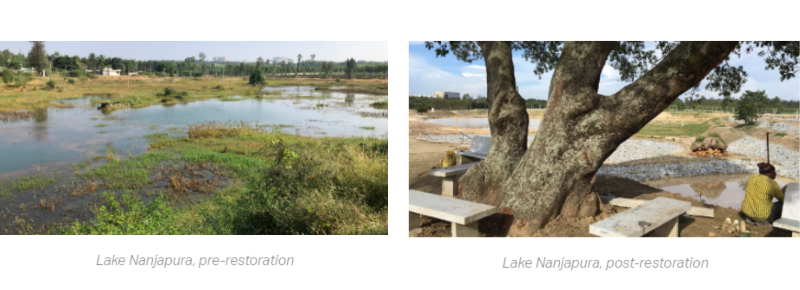It’s 7am in Bengaluru, and the quiet chilly morning is punctuated by the melodious trill of an Indian robin as it flits among the trees fringing the recently restored Lake Nanjapura. In a field nearby, a farmer sows for what he hopes will be a bountiful harvest through the now-rejuvenated groundwater.
This is in contrast to the barren and dry lake a few years ago, before Intel adopted Lake Nanjapura and Lake Dyavasandra in 2020 as part of its sustainability goals.
Back then, the accumulation of silt, clogging of its inlets, sewage, groundwater exploitation, and other factors meant that the lakes didn’t hold the true potential of rainwater, and often dried down to a trickle in summer.
This has been a recurring story of many water bodies located within or near cities in India, particularly in Bengaluru, due to urbanisation.
About 30 percent of the population in India lives in cities and it is expected to double by 2050. Groundwater is being exploited faster than it can be replenished and is being increasingly polluted.
Global water restoration goals
As part of its commitment to sustainable water management both within and outside its operations, Intel is taking action.
With a goal to achieve net positive water use by 2030, Intel is restoring fresh water in two ways— by treating water from its operations and through community projects. The concept of net-positive water use involves not only optimising consumption and recycling of water but also storing water from rainfall to put more back into the system than is taken out.
As the largest Intel engineering site outside the US, Intel India is advancing Intel’s global water restoration goals as part of Intel RISE (Responsible, Inclusive, Sustainable and Enabling) strategy.
“As part of Intel's RISE 2030, one of our sustainability goals is to achieve net positive water use. Driving water conservation efforts through collaboration with local communities is an important step in that direction. I am proud and excited that Intel has enabled the rejuvenation of two lakes in Bengaluru – Nanjapura and Dyavasandra – that have regenerated groundwater sources with a potential of conserving 120 million gallons of water a year and rekindled biodiversity in the localities. This was truly a collaborative effort and our sincere thanks to local communities, NGO partners and government for their support. We stay committed to making our surroundings cleaner, greener and sustainable”, Nivruti Rai says, country head, Intel India and VP, Intel Foundry Service.
Water conservation benefit of 120 million gallons every year:
Intel India in partnership with CLEAN International and Bengaluru-based Say Trees has rejuvenated lakes Nanjapura and Dyavasandra with the potential to add an estimated 120 million gallons of water to the ground level.
Nestled in southern Bengaluru, just south of Intel’s state-of-the-art campus on Sarjapur Ring Road, Lake Nanjapura, once a vibrant resource for its neighboring communities, was filled with sediment, preventing it from capturing the water from the monsoon and other rains that farmers rely on for agriculture.
For a couple of years, we were facing a severe drinking water problem in our panchayat. We had to supply water to the villages through tankers, as borewells had dried up. Ever since the Nanjapura lake has been rejuvenated, the groundwater has been recharged so well that recently we dug a borewell at 340 feet, unlike 1300 feet earlier. We are now able to use the water for drinking and for our fields. We look forward to working with Intel India on other projects in the future,” says Girish Kumar, a member of the Hulimangala Panchayat.

The complete restoration project took place in 2020 amidst the pandemic. Restoring the lake involved desilting, erosion control, bund building, and planting of over 6,000 trees, rejuvenating an adjacent Miyawaki Forest, a tank for idol immersion, and developing a walking path around the lake.
“We’re happy to share that after a good monsoon season, the lake is now filled to capacity. The community has started seeing water in wells that were once dry. A microclimate has been created, the Miyawaki forest is now thriving and home to a variety of birds. They are attracted to the food bearing trees planted as part of the initiative. In fact, people have also started fishing from the lake, again,” says Kapil Sharma, Founder and Director, SayTrees.

Similarly, the lake Dyavasandra project taken up in 2020 offers the benefit of recharging groundwater, with an estimated restoration benefit of 77 million gallons per year. Over 1500 trees planted along the lake spread across 30 acres catalyse allied benefits like natural wetland filtration, creating a microclimate through afforestation, and outdoor space for local community members.
Giving back to the community
“We received very good support from the communities.. True sustainability involves maintaining it, living by it, and making sure that it really is taken care of. It’s important therefore, to find people who are motivated to be a part of the restoration,” says Heather Baker, president, CLEAN International, the global organisation that works with on-the-ground conservation and restoration initiatives, water, and sanitation projects.
